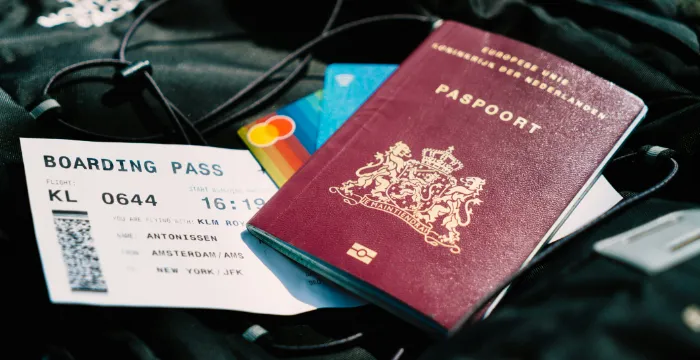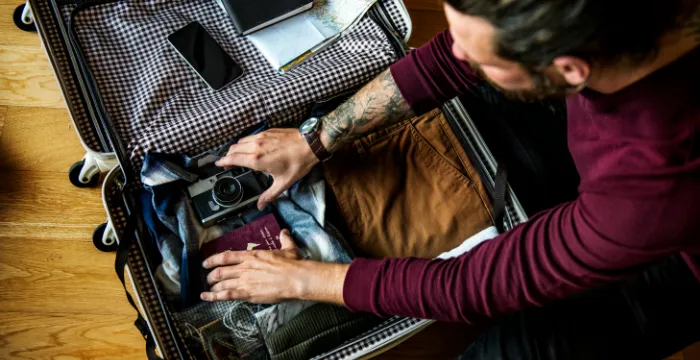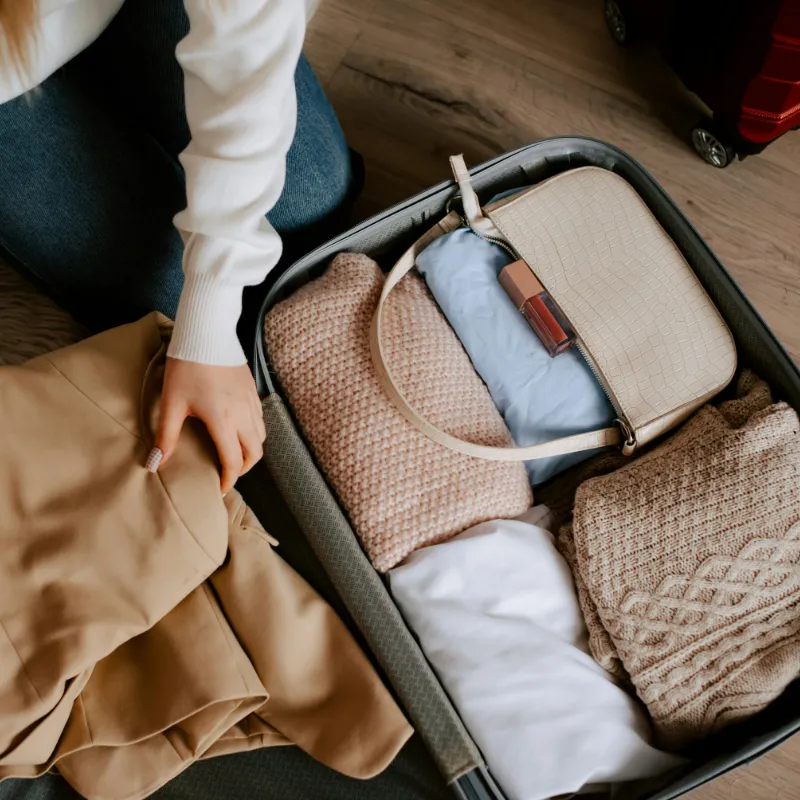How To Plan Your First International Trip: A Complete Guide
Your first international trip isn't just a travel. It’s a milestone, a leap into the unknown and a life changing experience.
But as exciting as the prospect of exploring new cultures and landscapes is, the planning process can feel daunting. Visas, flights, accommodation, itineraries, budgeting... Where do you even begin?
Fear not, intrepid traveler! This comprehensive guide is designed to demystify the process of planning your first international trip. We’ll break down every essential step, from choosing your destination to packing your bags, ensuring you feel confident, prepared and ready to embrace the adventure of a lifetime.
- Phase 1: The Dream – Laying the Groundwork
- Phase 2: The Logistics – Booking & Officialities
- Phase 3: The Plan – Itinerary & Money Matters
- Phase 4: The Preparation – Packing & Last-Minute Checks
- Phase 5: The Journey – Embracing the Adventure
Phase 1: The Dream – Laying the Groundwork
Before you book anything, take some time to dream, research and establish the core parameters of your trip. This foundational phase is crucial for building a cohesive and enjoyable travel plan.
1. Define Your Travel Style & Goals: What kind of traveler are you? What do you hope to gain from this experience?
- Adventure Seeker? Hiking, diving, extreme sports.
- Culture Enthusiast? Museums, historical sites, local festivals, culinary experiences.
- Relaxation-Focused? Beaches, spas, leisurely strolls.
- Budget-Conscious? Hostels, street food, free attractions.
- Luxury Traveler? High-end hotels, fine dining, exclusive experiences.
- Solo, Couple or Group? This will influence your destination and activities.
Understanding your preferences will narrow down your options and help you choose a destination that truly excites you.
2. Choose Your Destination (Wisely for a First Trip): For your first international trip, consider destinations known for being relatively easy for first-timers. Look for:
- English widely spoken: This reduces communication barriers.
- Good infrastructure: Reliable public transport, safe areas, readily available information.
- Political stability: Avoid regions with current unrest or high travel advisories.
- Affordability: Some regions are inherently more budget-friendly than others.
- Personal Interest: Ultimately, pick somewhere that genuinely captivates you!
Recommended First-Timer Destinations (Just a Few Examples For a First International Trip):
- Europe (Western/Central): UK, Ireland, France, Italy, Spain, Germany, Netherlands. Excellent transport, rich history, diverse culture.
- Canada/Mexico (for US travelers): Proximity and often familiar culture, yet distinctly international.
- Southeast Asia (Thailand, Vietnam, Cambodia): Incredibly welcoming, budget-friendly, rich culture and stunning landscapes, though some might find the initial culture shock more pronounced.
- Australia/New Zealand: English-speaking, safe, stunning natural beauty, but can be expensive and far for many.
3. Determine Your Budget: Be realistic. Your budget will dictate everything from your destination to your accommodation and activities.
- Flights: Often the largest single expense.
- Accommodation: Hostels, guesthouses, hotels, Airbnb.
- Food: Eating out, groceries, street food.
- Transportation: Public transport, taxis, rental cars, inter-country travel.
- Activities & Sightseeing: Tours, museum entry fees, excursions.
- Travel Insurance: Non-negotiable!
- Visas & Vaccinations: Potential costs here.
- Shopping/Souvenirs: Factor in some fun money.
- Emergency Fund: Always have extra cash for unforeseen circumstances.
Read our Budgeting for travel: tips and tricks dedicated article.
Start a spreadsheet to track potential costs. Research average costs for your chosen destination.
4. How Long Will You Go For? Your trip duration impacts your budget and how much you can realistically see.
- Short Trip (1-2 weeks): Focus on one country or a small region. Ideal for dipping your toes in.
- Medium Trip (2-4 weeks): Allows for more in-depth exploration or visiting 2-3 neighboring countries.
- Long-Term (1+ month): Requires more extensive planning, budgeting and potentially different visa considerations.
For a first trip, 1-3 weeks is often a sweet spot, enough time to experience a place without feeling overwhelmed.
Phase 2: The Logistics – Booking & Officialities

With your dream in mind, it's time to tackle the concrete steps of booking and preparing your official documents for your first international trip.
1. Passport Power: Check Validity! This is the absolute first thing you must do.
- Does your passport expire within 6 months of your return date? Many countries require this for entry. If not, renew it immediately. Passport renewal can take weeks or even months, so don't delay.
- Do you have enough blank pages? Some countries require several.
2. Visa Requirements: Don't Get Denied! Research the visa requirements for your nationality traveling to your chosen destination.
- Schengen Area (Europe): Many nationalities can enter visa-free for up to 90 days.
- Electronic Travel Authorization (ETAs/eVisas): Countries like Canada (eTA), Australia (ETA), and many others offer online applications.
- Traditional Visas: Some countries require you to apply in advance through their embassy or consulate. This can be a lengthy process with interviews and extensive documentation.
- Transit Visas: If you have a layover in a third country, check if a transit visa is needed, even if you don't leave the airport.
Always check official government websites (your country's foreign affairs department and the destination country's embassy/consulate) for the most up-to-date information.
3. Book Your Flights: This is often the biggest commitment and can significantly impact your budget.
- Flexibility is Key: If your dates are flexible, use tools like Google Flights "explore" feature or Skyscanner's "Cheapest Month" to find the best deals. Mid-week flights are often cheaper.
- Book in Advance: Generally, 2-6 months out is a good window for international flights.
- Incognito Mode: Search for flights in incognito/private browsing mode to avoid dynamic pricing based on your search history.
- Consider Layover Times: For your first trip, avoid extremely tight connections (less than 2 hours) to account for potential delays or getting lost in large airports.
- Check Luggage Allowance: Understand the carry-on and checked baggage rules for your chosen airline to avoid surprise fees.
4. Secure Accommodation: Book at least your first few nights in advance, especially if you're arriving late or in an unfamiliar city.
- Hostels: Great for budget travelers and meeting people (check reviews for cleanliness, safety and atmosphere).
- Hotels: Range from budget to luxury.
- Airbnb/Vacation Rentals: Offers a more local experience and often kitchen facilities.
- Guesthouses/B&Bs: Often charming, locally run options.
Read reviews extensively! Look at location (proximity to public transport, attractions, safe neighborhoods), amenities and cancellation policies.
5. Travel Insurance: Absolutely Essential! Do not skip this. Travel insurance covers:
- Medical Emergencies: Treatment, hospitalization, evacuation.
- Trip Cancellation/Interruption: If you can't go or have to cut your trip short due to unforeseen circumstances.
- Lost/Stolen Baggage: Reimbursement for belongings.
- Travel Delays: Coverage for extra expenses incurred due to flight delays.
Compare policies carefully, understanding what's covered and what's excluded.
6. Health & Vaccinations:
- Consult Your Doctor: Schedule an appointment 4-6 weeks before your trip to discuss necessary vaccinations (e.g., Hepatitis A/B, Typhoid, Yellow Fever) and any health precautions for your destination.
- Prescription Medications: Ensure you have enough for your trip, plus a few extra days. Keep them in their original packaging with a copy of your prescription. Check if your medications are legal in your destination country.
- Basic First-Aid Kit: Include pain relievers, band-aids, antiseptic wipes, allergy medication, stomach remedies and any personal necessities.
Phase 3: The Plan – Itinerary & Money Matters
With the major bookings done, it's time to refine your itinerary and sort out your finances for smooth sailing.
1. Craft Your Itinerary (But Stay Flexible!): Research attractions, activities and local events.
- Balance: Don't overschedule. Allow for downtime, spontaneous discoveries and travel time between locations.
- Group Activities: Cluster nearby attractions together.
- Transportation: Plan how you'll get between cities or regions (trains, buses, domestic flights, rental cars). Book major inter-city transport in advance, especially during peak season.
- Experiences: Mix major tourist sites with local experiences (e.g., cooking classes, market visits, neighborhood walks).
- Food: Research local cuisine and try to find highly-rated local eateries.
While a plan is good, remember that travel often involves unexpected detours. Embrace them!
2. Money Matters: Currency & Access:
- Currency Exchange: Understand the local currency. You can exchange money at home, at the airport (often poorer rates) or at banks/ATMs abroad.
- Notify Your Bank/Credit Card Companies: Inform them of your travel dates and destinations to prevent them from flagging your transactions as fraudulent.
- Credit/Debit Cards: Check for foreign transaction fees. Consider getting a travel-friendly credit card with no foreign transaction fees and good rewards.
- ATMs: Generally, the best way to get local currency at a good exchange rate. Look for ATMs associated with reputable banks.
- Cash: Always carry some local currency for small purchases, tips, or emergencies, especially in countries where cash is king.
- Budget Tracking: Use a simple app or notebook to track your spending daily.
3. Learn Basic Phrases: Even a few words in the local language can go a long way in showing respect and making connections.
- "Hello," "Thank you," "Please," "Excuse me," "Yes," "No."
- "Where is the bathroom?" "How much does this cost?"
- Download a translation app for more complex conversations.
4. Download Offline Maps & Essential Apps:
- Google Maps (offline): Download maps of your destination for navigation without data.
- Transportation Apps: Local public transport apps (e.g., Citymapper), ride-sharing apps (Uber, Grab, local equivalents).
- Translation Apps: Google Translate, iTranslate.
- Accommodation Apps: Booking.com, Airbnb.
- Communication Apps: WhatsApp (widely used internationally).
- Entertainment: Books, podcasts, movies for long flights/train rides.
5. Inform Others & Leave an Itinerary:
- Family/Friends: Let them know your travel plans, including flight details and accommodation.
- Emergency Contact: Provide them with copies of your passport, insurance and flight info.
- Register with Your Embassy: Many countries offer services for citizens traveling abroad (e.g., STEP program in the US, Smartraveller in Australia). This helps them locate you in an emergency.
Phase 4: The Preparation – Packing & Last-Minute Checks

The final countdown! These steps ensure you’re physically and mentally ready for departure.
1. Packing Smart: The Art of the Travel Minimalist:
- Less is More: You will always regret overpacking. Aim to pack light, especially if you plan to move between multiple locations.
- Versatile Clothing: Choose neutral colors that can be mixed and matched. Layering is key for varying temperatures.
- Comfortable Shoes: You'll be doing a lot of walking. Bring at least two comfortable pairs.
- Essentials: Toiletries (travel-sized), medications, adapter/converter for electronics, portable power bank.
- Copies of Documents: Keep digital copies (on your phone, cloud storage) and physical photocopies of your passport, visa, flight confirmations and insurance. Store them separately from the originals.
- Day Bag: A small backpack or cross-body bag for daily essentials.
- Consider a Travel Towel: Lightweight and quick-drying.
- Packing Cubes: A game-changer for organizing your luggage.
2. Security & Safety Awareness:
- Research Local Scams/Risks: Be aware of common tourist scams in your destination.
- Stay Aware of Your Surroundings: Especially in crowded areas.
- Protect Valuables: Use a money belt or secure pocket for passport and cash. Don't flash expensive jewelry or electronics.
- Trust Your Gut: If a situation feels off, remove yourself.
- Emergency Numbers: Know the local emergency services number (e.g., 112 in Europe).
3. Phone & Connectivity:
- International Roaming: Check costs with your provider (often expensive).
- Local SIM Card: Usually the most cost-effective option for data and calls. Buy one upon arrival at the airport or a local phone store.
- eSIM: Some newer phones support eSIMs, allowing you to activate a local plan digitally.
- Wi-Fi: Rely on free Wi-Fi in hotels, cafes and public areas where available.
4. Final Checks (The Week Before):
- Confirm All Bookings: Flights, hotels, tours.
- Pack Your Bags: Make sure everything fits and meets airline requirements.
- Empty Your Wallet: Remove unnecessary cards and leave them at home.
- Arrange Pet/Mail Care: If needed.
- Charge All Electronics: Smartphone, tablet, pocket translator, power bank.
- Set Up Out-of-Office: For email.
- Get Enough Sleep: You'll want to be well-rested for your journey.
Phase 5: The Journey – Embracing the Adventure
You've planned, you've packed, now it's time to experience!
1. At the Airport:
- Arrive Early: Especially for international flights (3 hours before departure is standard).
- Check-in: Online beforehand or at the airport.
- Security: Be prepared (liquids, electronics out).
- Customs/Immigration: Have your passport, visa (if applicable) and any required forms ready. Be polite and honest.
2. Managing Jet Lag:
- Adjust Before You Go: Gradually shift your sleep schedule a few days prior.
- Hydrate on the Flight: Drink plenty of water, avoid excessive alcohol and caffeine.
- Adjust Immediately: Upon arrival, try to get into the local time zone. If it's daytime, stay awake. If it's night, try to sleep.
- Get Sunlight: Helps to reset your day rhythm.
3. Be Open-Minded & Flexible:
- Embrace Culture Shock: It's normal to feel disoriented. Observe, learn and be respectful of local customs.
- Things Will Go Wrong: Flights get delayed, you might get lost, something might close. It’s part of the adventure. How you react determines your experience.
- Try New Things: Foods, activities, conversations.
- Talk to Locals: They often provide the best insights and recommendations.
4. Stay Safe & Present:
- Trust Your Instincts: If a situation feels unsafe, remove yourself.
- Keep Your Wits About You: Don't get overly intoxicated or wander alone in unfamiliar areas at night.
- Document, Don't Just View: Take photos, keep a journal, but also take time to simply observe and be present in the moment.

Conclusion
Your first international trip is an unparalleled opportunity for growth, discovery and creating memories that will last a lifetime. While the planning process can seem overwhelming, breaking it down into manageable steps makes it much less intimidating. By being thorough, realistic and open to the unexpected, you'll set yourself up for an incredible adventure. So, take a deep breath, trust your preparations and get ready to fall in love with the world. Happy travels!




